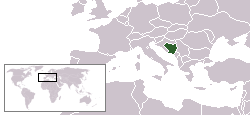Bosnia and Herzegovina (Bosnian: Bosna i Hercegovina, Босна и Херцеговина, usually shortened to BiH) is a European country on the Balkan Peninsula. Mostly mountainous, it has access to a tiny portion of the Adriatic Sea coastline in the south. Visitors find well-restored historic cities, a warm and welcoming atmosphere, bustling city life and medieval monuments.
Regions[edit]
Bosnia denotes the much larger northern region, comprising several geographic/historical subregions, and Herzegovina is the fairly compact southern part of the country. Here is a traveler-friendly division of the nation based on traditional regions (and subregions):

| Bosanska Krajina northwestern part of the region of Bosnia, "hugged" by Croatia |
| Central Bosnia |
| Herzegovina south of country, traditionally inhabited by Croats mostly and the only region with coastal access. |
| Northeastern Bosnia |
| Posavina a northern part of the region of Bosnia, along the Sava River, reaching into the Pannonian basin |
| Sarajevo Region An eastern part of the region of Bosnia, containing the nation's capital and environs |
Cities[edit]
- 1 Sarajevo — the national capital; a cosmopolitan European city with a unique Eastern twist as can be seen in its vast diversity of architectural styles
- 2 Banja Luka — the second largest city, serving as the de facto capital of Republika Srpska, with some historical sights and a rich nightlife
- 3 Bihać — city near Croatian border, surrounded by an impressive nature preserve.
- 4 Jajce — a small city with a beautiful waterfall and number of historical attractions dotted around its centre
- 5 Mostar — a nice old town on the Neretva River, symbolised by its medieval bridge
- 6 Neum — the only coastal town, with sandy beaches backed by steep hills
- 7 Tuzla — third largest city with much industry, though has a lovely old town and monuments to the brutal war too
- 8 Teslic — а health spa resort with the biggest tourist capacity in the country
- 9 Zenica — city with an Ottoman old quarter
Other destinations[edit]
- 1 Kozara — national park in the north-west with dense forests and hilly meadows, a hiking and hunting destination.
- 2 Međugorje — inland town between mountains with a mild Mediterranean climate, but perhaps best known due to claims of apparitions of the Virgin Mary to six locals.
- 3 Srebrenica — small town in the north-east with beautiful nature (the Drina Canyon, the third deepest canyon in the world), but best known as the site of a genocidal massacre during the Bosnian War.
Understand[edit]
Meaning of "Bosnia" and "Herzegovina"[edit]
The first thing to grasp is that while Bosnia and Herzegovina is commonly seen as a politically divided nation, and as a unique kind of a federal country, comprising two political units (mainly...), these units are decidedly not "Bosnia" and "Herzegovina". Not only are the units (which are constitutionally labelled as "entities") not named "Bosnia" and "Herzegovina"—they don't even roughly correlate to these terms. Regardless, Bosnia and Herzegovina very much still is "Bosnia plus Herzegovina", as these names denote traditional, historical, regions that comprise the entire nation's territory.
It was part of Yugoslavia until it gained independence in 1992.
Political subdivision[edit]
Constitutionally, the nation is divided into two "entities" (they're the easiest to compare to federal units):
- Federation of Bosnia and Herzegovina (or FBiH) with a predominant Bosnian/Croatian population
- Republika Srpska (i.e. Serbian Republic/Republic of Serbs or RS) with a Serbian majority population
Territorially, they take up portions of both the region of Bosnia and the region of Herzegovina. Each has its own capital, government, president, parliament, and police departments. Until 2006, Republika Srpska even had its own armed forces. Along with the two entities, there's a third something: The District of Brčko is a small area within Posavina, that acts as a condominium of the two entities.
|
Bosnia and Herzegovina as a federal-sort-of nation Bosnia and Herzegovina, as a nation, is not explicitly federal. Note that the Federation of Bosnia and Herzegovina, as one of the two entities, has "Federation" in its name because it comprises ten cantons. Each canton has a cantonal government with its prime minister, alongside various agencies (such as tourist boards), etc. It is these ten cantons that are in a federation and not the two entities. Unlike FBiH, Republika Srpska does not have cantons. |
|
No national tourist board There are several official tourism associations operating in BiH, but none at the national level. At the entity level, there is only the Tourism organisation of Republika Srpska. At the canton level (FBiH does not have its tourist board), each canton should ostensibly have its tourist board, but most are either defunct or simply don't have a website; the operational ones are:
|
BiH and conflict[edit]
The idea of a Bosnian nationality is used to mainly apply to the nation's Muslims, also referred to as Bosniaks. Bosnia's Catholics and Orthodox Christians looked up to Croatia and Serbia respectively for guidance and as the parent country and both had aspirations for political union with either Croatia or Serbia once the Yugoslavian union began to fall apart in the early 1990s. This spelled disaster for the state of Bosnia and Herzegovina, resulting in a bloody civil war fought between all three groups. In the end the Bosnian-Croatian alliance fought the Serbian forces on the ground whilst NATO attacked the Bosnian Serbs from the air, causing a military defeat for the Serbs.
A peace treaty followed, with the detailed scrutiny of the U.S. Clinton administration helping seal the deal. The result was that Bosnia and Herzegovina would be a federation of sorts, comprising a Bosnian-Croatian unit and a Serbian unit.
Bosnia and Herzegovina functions as one country with two or even three different parts. However, the central government lies in Sarajevo and there is one common currency, the convertible mark, denoted locally as KM (international code: BAM). The currency was named after and was pegged one-to-one to the Deutschmark (German currency prior to the euro).
History[edit]
- 9 May 1945
- End of World War II (National Holiday)
- National holiday in Federation of BiH
- 25 November: Bosnia and Herzegovina's declaration of sovereignty in October 1991, was followed by a declaration of independence from the former Yugoslavia on 3 March 1992 after a referendum boycotted by ethnic Serbs. This national holiday is not commemorated in the RS.
- National holiday in Republika Srpska
- 9 January: The Day of the Republic. On 9 January 1992, the Bosnian Serb Assembly adopted a declaration on the Proclamation of the Serbian Republic of Bosnia and Herzegovina. In August 1992, the reference to Bosnia and Herzegovina was dropped from the name, and it became "Republika Srpska".
- Independence
- 1 March 1992 (from Yugoslavia; referendum for independence was completed 1 March 1992; independence was declared 3 March 1992)
The Bosnian Serbs, supported by neighbouring Serbia and Montenegro, responded with armed resistance aimed at partitioning the republic along ethnic lines and joining Serb-held areas together to form a "greater Serbia". In March 1994, Bosniaks and Croatians reduced the number of warring factions from three to two by signing an agreement creating a joint Bosniak-Croatian Federation of Bosnia and Herzegovina. On 21 November 1995, in Dayton, Ohio, the warring parties signed a peace agreement that brought to a halt the three bloody years of ethno-religious civil strife (the final agreement was signed in Paris on 14 December 1995).
- Constitution
- the Dayton Agreement, reached at Wright-Patterson Air Force Base near Dayton, Ohio, United States, on 21 November 1995, and signed in Paris on 14 December 1995, included a new constitution now in force;each of the entities also has its own constitution.

The Dayton Agreement retained Bosnia and Herzegovina's international boundaries and created a joint multi-ethnic and democratic government. This national government was charged with conducting foreign, economic, and fiscal policy. Also recognised was a second tier of government comprised of two entities roughly equal in size: the Bosniak/Croat Federation of Bosnia and Herzegovina and the Bosnian Serb-led Republika Srpska (RS). The Federation and RS governments are charged with overseeing internal functions.
In 1995–96, a NATO-led international peacekeeping force (IFOR) of 60,000 troops served in Bosnia to implement and monitor the military aspects of the agreement. IFOR was succeeded by a smaller, NATO-led Stabilisation Force (SFOR) whose mission is to deter renewed hostilities. SFOR was shut down at the end of 2004. Some foreign troops remained until at least 2013.
Culture[edit]
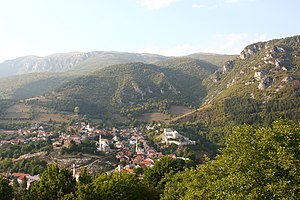
Bosniaks, Croatians and Serbians form the largest ethnic groups in the country. Since the break-up of Yugoslavia, Bosniak has replaced Muslim as an ethnic term in part to avoid confusion with the religious term Muslim — an adherent of Islam. Ethnicity and religion mostly overlap; with Muslims (mostly Bosniaks), Roman Catholic Christians (mostly Croatians) and Orthodox Christians (mostly Serbians) being the three main religious groups of the country. There are also some Roma, Protestants and Jews as well. Nevertheless, the country is highly secular and religion is seen as more of a traditional and cultural identity than a set of rituals and rules.
Climate[edit]
Hot summers and cold winters; areas of high elevation have short, cool summers and long, severe winters; mild, rainy winters along coast
Terrain[edit]
A succession of mountains with relatively few intervening fertile valleys. There are occasional earthquakes and the highest point is Maglić at 2,386 m. There are several national parks. The mountainous terrain offers spectacular views.
Talk[edit]
- See also: Bosnian phrasebook
The official languages in Bosnia and Herzegovina are Bosnian, Serbian and Croatian, all three known as Serbo-Croatian as they are practically the same language. Serbo-Croatian is written in both Latin and in Cyrillic, making it the only Slavic language to officially use both scripts. In the Republika Srpska you'll see signs in Cyrillic, so a Serbian-English dictionary would be helpful there.
Variants among the Serbo-Croatian language differ only in the most academic of venues and also in traditional homes. There are different versions of the language throughout the area and spoken language changes between regions. However, the vocabulary differences are only cosmetic and do not hinder communication between Bosnian Muslims, Catholic Croatians and Orthodox Serbs.
Most younger Bosnians who grew up after the fall of communism speak English. Many Bosnians speak German owing to family connections as well as tourism in former Yugoslavia before the war. Some older people are also able to speak Russian, as it was taught in schools during the communist era. Other European languages (e.g. French, Italian, Greek) are only spoken by a few educated individuals.
Get in[edit]
Entry requirements[edit]

Passport holders of the following countries do not need a visa to enter Bosnia and Herzegovina when the purpose of the visit is tourism for up to 90 days (unless otherwise noted): Albania, Antigua and Barbuda, Andorra, Argentina, Australia, Austria, Azerbaijan, Bahamas, Bahrain, Barbados, Belgium, Brazil, Brunei, Bulgaria, Canada, Chile, Colombia, Costa Rica, Croatia, Cyprus, Czech Republic, Denmark, Dominica, El Salvador, Estonia, Finland, France, Georgia, Germany, Greece, Grenada, Guatemala, Holy See, Hong Kong, Hungary, Iceland, Ireland, Israel, Italy, Japan, Kiribati, Kuwait, Latvia, Liechtenstein, Lithuania, Luxembourg, Macau, Malaysia, Malta, Marshall Islands, Mauritius, Mexico, Micronesia, Moldova, Monaco, Montenegro, Netherlands, New Zealand, Nicaragua, North Macedonia, Norway, Oman, Palau, Panama, Paraguay, Peru, Poland, Portugal, Qatar, Romania, Russia (30 days), Saint Kitts and Nevis, Saint Lucia, Saint Vincent and the Grenadines, Samoa, San Marino, Serbia, Seychelles, Singapore, Slovakia, Slovenia, Solomon Islands, South Korea, Spain, Sweden, Switzerland, Taiwan, Timor-Leste, Trinidad and Tobago, Turkey, Tuvalu, Ukraine (30 days), United Arab Emirates, United Kingdom, United States, Uruguay, Vanuatu and Venezuela.
Citizens of the following countries can enter and stay up to 90 days with their National ID card: Austria, Belgium, Bulgaria, Croatia, Cyprus, Czech Republic, Denmark, Estonia, Finland, France, Germany, Greece, Hungary, Iceland, Ireland, Italy, Latvia, Liechtenstein, Lithuania, Luxembourg, Malta, Monaco, Montenegro, Netherlands, North Macedonia, Norway, Poland, Portugal, Romania, San Marino, Serbia, Slovakia, Slovenia, Spain, Sweden and Switzerland.
Anyone not covered by one of the visa exemptions listed above must apply for a visa at an embassy or consulate of Bosnia and Herzegovina in advance. However, valid multiple entry visa holders and residents of the European Union, Schengen Area member states, and United States of America can enter Bosnia and Herzegovina without a visa for a maximum stay of 30 days. This is not applicable to holders of Kosovar passport..
More information about visa exemptions and the visa application procedure is available at the website of the Ministry of Foreign Affairs.
By plane[edit]
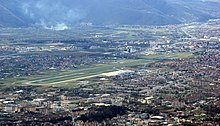
Sarajevo Airport (SJJ IATA) is the main entry point by air.
Bosnia has no airlines of its own.
Croatia Airlines connects Sarajevo via Zagreb, and from there connections are possible to Brussels, Frankfurt, London, Munich, Paris, Zürich and several other European cities.
Air Serbia connects Sarajevo daily via Belgrade and from there one can connect with other Air Serbia domestic and international flights.
Norwegian also operates to the airport. For other services, check the Sarajevo Airport website.
Mostar (OMO IATA), Tuzla (TZL IATA) and Banja Luka (BNX IATA) also have international airports.
Many travellers choose to fly into Croatia, continuing travel by bus to BiH, on Zagreb, Split, Zadar or Dubrovnik being serviced by cheap flights.
By train[edit]
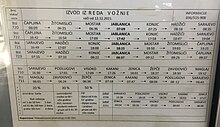
Train services across the country are slowly improving, though speeds and frequencies are still low. Much of the rail infrastructure was damaged during the 1990s conflict, and lines have been opened on a priority basis, though not to the high level of service pre-war. The train services are operated by the two entities (based on the political division of the country), which results in the locomotives being changed rather often.
From Croatia[edit]
The Zagreb-Bosnia train seems to be cancelled since December 2016 until further notice.
There is one daily train running from Sarajevo to Zagreb (10 hours), the capital of Croatia, and onwards to the rest of Europe.
The 'day' train leaves from Zagreb at 08:59 and arrives in Sarajevo at 18:23. The return journey departs Sarajevo around 10:21 and coming to Zagreb at 19:42. Ticket costs around €30 one way (return ticket cost around €50). Tickets can be purchased in the international office at train station in Croatia or in Bosnia in local currency. There is no buffet car on this route so take supplies beforehand for the spectacular 9-hr trip, though men with small trolleys will occasionally walk through the train selling overpriced soft drinks etc.
Aim to buy your ticket before you board the train. If you don't buy before you board then buy from the conductor onboard but he/she may only sell you a ticket for his/her part of the journey; the staff and locomotives usually change when the train leaves Croatian territory and again when the train goes from the territory of Republika Srpska into the Federation.
Special tickets[edit]
Travelling to Bosnia is possible with an Interrail-pass. In Bosnia, other Balkans countries and Turkey also with the Balkan Flexipass.
By car[edit]
Border crossings normally pose few problems, but some border crossings are heavily congested during some parts of the year.
As of 2009, the main routes from the coast via Mostar to Sarajevo, and north from Sarajevo to the Croatian border at Slavonski Brod/Slavonski Šamac, have been restored and are of excellent quality.
A new highway which follows this path is under construction, with the first part north of Sarajevo readily available, although some construction may slow down traffic at each end of this projected highway. From Sarajevo side you will have to pay toll of 2 km for passenger car. Toll booths at the opposite end as of 2011 were being installed and not functioning.
When finished, this highway will connect the northern part of Croatia with the coast as well as the new highway from Zagreb to Split, which eventually will extend to Dubrovnik.
By bus[edit]
Buses are plentiful in and around Bosnia. A list of bus stations and timetables in Bosnia can be found here [1]
Most international buses arrive at the main Sarajevo bus station (autobuska stanica) which is next to the railway station close to the centre of Sarajevo. A few buses from Belgrade, the Republika Srpska entity and Montenegro use the Lukavica bus station in Istočno (Eastern) Sarajevo (the Serbian neighbourhood of the town).
Frequent coach services run from Sarajevo to:
- Croatia: Zagreb (4 daily), Split (4 daily), Rijeka and Pula (daily), and Dubrovnik (daily at 06:30)
- Serbia: between Belgrade and (eastern) Sarajevo there are 5 daily services, there is also a daily service to Sarajevo main station
- Slovenia: Ljubljana (daily)
- Montenegro: Kotor daily (the trip is 7 hours and has spectacular views)
in addition to the longer-distance buses further afield to North Macedonia, Austria and Germany.
From Mostar, Banja Luka, Tuzla and Zenica are also frequent international services. Herzegovina also has many bus services from the Dalmatian coastal cities of Croatia.
International bus services are nearly always in modern, luxurious 5-star coaches - the only exceptions to this are normally the local buses operating slightly over the border (max. 3 hour trips).
Companies[edit]
Due to significant emigration during the Bosnian war in the 1990s, there are a number of bus companies that serve the Bosnian diaspora by providing cheap and clean transport to the other side of Europe.
- Centrotrans, Based in Sarajevo (buses are operated through the regular bus stations around the country), ☏ +387 33 46 40 45, fax: +387 33 46 40 40, info@centrotrans.com. Centrotrans operates for Eurolines to Austria, Belgium, Croatia, Denmark, France, Germany, Montenegro, Serbia and Slovenia.
- Globtour (Operates from Međugorje, through the whole country), ☏ +387 36 653 253, fax: +387 36 653 251, miro@globtour.com. Regular buses to Germany, Austria, Sweden and Croatia.
- Semi tours, ☏ +387 61 596 443, fax: +32 36 638699, info@semi-tours.com. Cooperation with Eurolines and Centrotrans, several buses per week to Belgium and The Netherlands Return ticket from €137.
- Gold tours, ☏ +387 32 444 960, fax: +387 32 444 961, goldze@bih.net.ba. Buses to Belgium, The Netherlands, Luxembourg and Switzerland. Return ticket from €100.
- Top Tourist, ☏ +387 66 30 8300, fax: +387 51 32 11 00, info@toptourist.dk. Weekly buses from and to Nordic European countries (e.g. Denmark, Sweden, Norway) Tickets can be paid on the bus, but advance booking and payment is recommended. Sarajevo via Salzburg (twice weekly) c. DKK1,000 (KM280, €140) return.
By boat[edit]
Bosnia has a quite small coastline in Neum. There is not a lot of harbour facilities, but they have two quays (with limited depth) and a gangway for ferries.
Ferries are available from Neum to other cities on the Adriatic connecting to Croatia and other countries. There are no international ferries across the Adriatic to Italy, but these do operate from Dubrovnik and Split.
Ferries, some of them privately run, are also available on inland rivers and lakes.
For going to Neum by own boat, it's possible to check-out in Ploče in Croatia, and then go to Neum and check in there. The harbour office in Neum is open on weekdays from 08 to 15. The fees for visiting Neum may be quite high, in the magnitude of hundreds of Euro. The procedure may be simplified by doing it through an agent. Compared to the ease of going from Croatia to Bosnia by car, bike or feet, going by own boat is a major hassle.
Get around[edit]
By car[edit]
|
Knowing which entity you're in There is free movement across the inter-entity border, so it is essentially not very different from U.S. state borders considering its impact on travel. One of the few practical implications is that the roadside assistance organizations are different: if you need something like towing services in Republika Srpska, you need to call the RS organization (☏ +387 1285) and vice versa (☏ +387 1282; depending on the exact location in FBiH another association may need to be called: ☏ +387 1288). |
Bosnia is a beautiful country to drive in; the scenery is often spectacular. Renting a car is a reasonable option, especially if you are visiting remote destinations outside of Sarajevo.
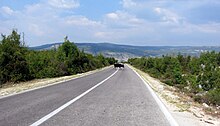
However, due to the mountainous terrain, dubious driving behaviour by some road users (including dangerous overtaking on narrow highways), and generally poor road conditions throughout the country, do not expect speeds will be fast - especially given the relatively short distance 'as the crow flies'.
If you drive to remote areas, roads can be downright dangerous, especially in more mountainous places like Sutjeska NP.
Petrol stations can be hard to find in some spots - often the best place to fill up is on the edge of towns and cities rather than in them.
Mechanics who speak English may be hard to find, and licensing may be an issue so ensure that you are allowed to drive there. Police regularly set up roadblocks; don't be surprised if they pull you over to check your papers and have a chat.
By bus[edit]
The best way to get around with public transport is with bus. There is a dense network of bus lines, all run by relatively small private companies. Be aware that if you buy a return ticket for a line which is served by more companies, you can only make the return trip with the company you bought the ticket at.
However, buses seem to be less frequent when there is the need to cross the ethnic borders. And in some regions the frequency can be very low or non-existent.
Notable bus companies include Autotrans, Centrotrans, Gluho and Lasta.
By train[edit]
Going by train is an option, but the connections are limited and slow (Federation, RS). For instance, there are two daily connections from and to Sarajevo.
Many train lines were damaged in the war, and have not yet been rebuilt. There is also a lack of carriages and trains to provide frequent services—even on the busy lines like Mostar-Sarajevo, Tuzla-Banja Luka and Sarajevo-Banja Luka. However, the rides are scenic, especially that Mostar-Sarajevo stretch.
Btw. taking a bicycle onto the train can be an issue.
Book the train online, it will save you time and will be the same price as at the counter in the terminal—also at the counter you have to pay the ominous booking fee.
As of 2023, train services in Bosnia and Herzegovina are severely limited. Many previously operational lines have been discontinued, and the train network in the Republika Srpska region in the north has been particularly affected. Several train lines were temporarily closed during the COVID-19 pandemic and have yet to resume operation.
Notably, the train journey between the two largest cities, Sarajevo and Banja Luka, is no longer possible, and this situation persists for unclear reasons. Only freight trains operate between these two major cities, as of 2023. Tuzla is not reachable by train either.
Don't be surprised by the train conductor checking your ticket with a cigarette in his lip. Most of the trains seem to permit smoking.
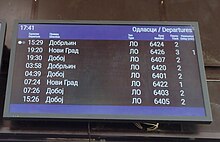
By thumb[edit]
Hitchhiking can be fun in Bosnia as you will get rides from local people who you wouldn't otherwise encounter. You might even be invited for an overnight stay. However be careful of landmines, and if you're not sure, stay on the paved road, and ask locals ("MEE-ne?").
Due to the ethnic division, it can be difficult to cross the borders from and to Srpska. In general, hitchhiking is rare in Bosnia and not always easy (Locals are eager to take you, the main reason why hitchhiking may be difficult is because there aren't always many cars around and many locals cannot afford a car). You might wait 5 min or 2 hours.
By bicycle[edit]
Cycling is beautiful in Bosnia. Other traffic is not so much used to how to relate to bikes on their way, though, and due to the driving behavior of Bosnian drivers, it can be very dangerous indeed.
[edit]
Google Maps in Bosnia includes public transport information, but is very rudimentary when it comes to outdoors and due to the mines situation it is important to have a better alternative. It does, however, still have its imperfections. Therefore, for reliable maps, GPS navigation, comprehensive trails and map information, consult OpenStreetMap, which is also used by this travel guide and by many mobile Apps like OsmAnd or Mapy.cz. Or just download the according GPX or KML files for such trails on OpenStreetMap through Waymarked Trails. You just need to change the OpenStreetMap relation ID to download the GPX or KML files through the same link.
If you are looking for detailed army maps, you can find a list here.
See[edit]


If Bosnia and Herzegovina makes you think of concrete Communist architecture or 1990s images of war-demolished town centres double-torn by ethno-religious strife, you're in for a pleasant surprise. Of course this country bears the marks of its tumultuous history, but visitors today find rebuilt and well restored historic cities, a warm and welcoming atmosphere, bustling city life and -overall- more medieval monuments than Socialist housing blocks. In fact, some of the remains of the Communist era, like the D-0 ARK bunker (otherwise known as Tito's Bunker) near Konjic, have become attractions of their own.
The country's main visitor draws however lie in its charming historic town centres, ancient heritage sites and splendid nature. Sarajevo has some of the most extensive Socialist housing projects, but is also a colourful historic mix of East and West, where religions and cultures coexisted for centuries. It's a vibrant town that resurrected into what it always was; the country's modern capital, proud of its heritage and a popular destination for travellers of all kinds. Top sights include the lively Baščaršija or Old Bazaar, the Sarajevo cathedral, the Gazi Husrev-beg's Mosque and of course the legacy sports facilities of the 1984 Olympics. Equally interesting is the Tunel spasa, or tunnel of hope, which brought supplies to the people of Sarajevo in the war and is now a museum. The beautiful old town of Mostar is another city gem, with the famous UNESCO World Heritage-listed Stari Most bridge as a main landmark. Carefully rebuilt, it's widely recognised as one of the finest examples of Islamic architecture in the Balkans. Višegrad has a Unesco listed bridge of its own, namely the impressive Mehmed Paša Sokolović Bridge. For more city grandeur, try the green gardens and avenues of Banja Luka. Finally, most components of the world heritage Stećci Medieval Tombstones Graveyards (medieval decorated tombstones) are in Bosnia and Herzegovina.
Great natural attractions can be found all around, even close to the main cities. Take a horse carriage to Vrelo Bosne (the spring of river Bosna) to join Sarajevo families for quiet getaways and picknicks. The waterfalls of Kravice, about 40km from Mostar, make for another fabulous natural trip. A popular spot for city dwellers and rafters, the water of the Trebižat River drops some 30 metres in a beautiful natural setting of tuff walls. Other dramatic waterfalls can be found in the far west of the country, in the lush Una National Park. And then of course, there is the famous Jajce waterfall, where the clear waters of the Pliva river drop 17 metres right in the middle of the town. Nature lovers may also want to include Hutovo Blato Natural Park for bird watching or Sutjeska National Park, with a waterfall as well as one of only two remaining primeval forests in Europe.
Top picks for village life can be found in the historic citadel of Počitelj, Blagaj (where you'll also find the spring of the river Buna) or, for environmentalists, in the Zelenkovac ecovillage near Mrkonjić Grad. Just outside of Radimlja is the largest collection of Stećak, a remarkable kind of pre-Ottoman tombstones that are found throughout the ancient Bosnian Kingdom.
Do[edit]
- Rafting. Rafting on the Neretva river, the Una river and the Tara with the Drina river, with some shorter courses on the Krivaja river, the Vrbas river and the Sana river.
2009 World championship of rafting was held in Banja Luka on the Vrbas river and in Foča on the Drina, both in RS. - Kayaking and canoeing. The Neretva river and its tributary the Trebižat, the Unac river, also the Krivaja river and its tributary Bioštica river are great kayaking destinations with a lot of whitewater on the Krivaja river. The Pliva river and its lakes Veliko and Malo are great canoeing destinations, also the middle and lower Una river, the Trebižat river.
- Canyoning. The famous Rakitnica canyon of the Rakitnica river, tributary of the Neretva river, offer great canyoning adventure, but even extreme canyoning route can be found in the Bjela river another tributary of the Neretva river. The Unac river and its canyon offer great canyoning route.
Also close to Banja Luka you can explore the canyons of the Svrakava and Cvrcka rivers. - Mountain biking. Sport is popular in the country, while mountainous terrain of the country getting increasingly popular destination for bikers from all over the world.
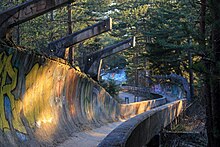
- Winter sports. Bosnia and Herzegovina was the 1984 host for the Winter Olympics, and it still takes pride of its winter sports potential. Especially around Sarajevo there are challenging venues. During the war of the 1990s many Olympic venues were severely affected, but today's skier will have a great experience.
Close to Sarajevo there are the Bjelasnica, with over 8 km of ski trails, the Jahorina (20 km) and Igman mountains. Close to Travnik is the Vlasic Mountain with 14 km. Other resorts are Blidinje, Vlasenica in the east and Kupres in Western Bosnia.
Bjelašnica and Jahorina are also beautiful for hikes during summer. - Fly-fishing. The most fly-fishing areas in Bosnia are in the North-West of the Bosanska Krajina, within National Park "Una", and around the river Sana [2].
Fly-fishing fanatics can go on a tour by the different trout-hotspots on the river Una, the Klokot, the Krušnica, the Unac, the Sana, the Bliha, the Sanica, the Ribnik, the Vrbas, the Pliva, the Janj, the Sturba, the Trebižat, the Buna, the Bunica, the Neretva, the Tara, the Sutjeska, the Drina, the Fojnica, the Bioštica, the Žepa, and many other smaller rivers and streams; most famous centres are Konjic, Glavatičevo, Tjentište within National Park "Sutjeska", Foča, Goražde, Bosanska Krupa, Bihać, Martin Brod, Drvar, Ribnik, Ključ, Sanica[3], Sanski Most, Šipovo, Jajce, Livno, Blagaj. In several of those towns there are resorts specially geared towards the needs of the angler.
Hiking[edit]
Hiking is great in the unspoiled nature of BiH. A great hub for close by and multiple day hikes is Jablanica, which has impressive Karst-mountains to the west and southeast of it.
When hiking to or around national parks, note that many national parks and sights have several entrances (i.e. routes) into them, but only the ones reached by car mostly have ticket stands. This means when around on foot, you can often not avoid to miss the ticket seller and thus getting in for free. You do not necessarily have to feel bad about that.
A good guidebook is Forgotten beauty:A hiker's guide to Bosnia and Herzegovina's 2000 metre peaks - and other selected adventures by Matias Gomez.
Some destinations well worth mentioning are:
- Jablanica – conveniently on the train route between Sarajevo and Mostar, the surrounding mountains offer several one- to several-days hikes east and southwest of the town. Several huts can be found along the trails, from well catered to basic ones.
- Foča – this town can be a gateway into several hiking destinations along the border to Montenegro, including Maglić Mountain, which lies on the other side of the border but can still be climbed from this side. The beautiful Sutjeska National Park is close by. The Montenegrin border is unclear at many locations, especially within the national park.
- 1 Uništa – the mountains around this small village (not directly accessible from the Bosnian side) contain a few huts, and on the Croatian side a popular "blue hole" can be found, which makes for some interesting and picturesque hikes.
- Una Falls – these waterfalls are within the Una National Park[dead link], which invites for several hike (one-day or multiday). You might even try hiking in along the rail tracks from the nearby town Ripač in the north. The entrances to the park are numbered and named accordingly, like "Entrance No. 1".
Buy[edit]
Money[edit]
|
Exchange rates for Konvertibilna marka As of January 2024:
Exchange rates fluctuate. Current rates for these and other currencies are available from XE.com |
The official currency is the konvertibilna marka (or marka) (convertible mark), denoted by the symbol "KM" (ISO code: BAM). It is fixed to the euro at the precise rate of 1.95583 for €1. Euro cash is also widely accepted, though mostly in denominations of €20 or less. 1 konvertibilna marka is equal to 100 fenings.
There are two sets of banknotes, with distinct designs for the Federation and the Republic of Srpska. However, both sets are valid anywhere in the country.
Coins are issued in denominations of 5-, 10-, 20 and 50 fenings, KM 1-, KM 2 and KM 5. Banknotes are issued in denominations of KM 10-, KM 20-, KM 50-, KM 100 and KM 200.
Before you leave the country, be sure to (!) convert back any unused currency into something more common (euros, dollars) as most other countries will not exchange KM, even other Balkan countries.
Credit cards are not widely accepted. Try to not pay with 100-KM or 200-KM notes, as smaller shops might not have enough change.
ATMs[edit]
ATMs are available in the most cities (Visa and Maestro). However, most will charge a considerable fee, which is added to the amount dispensed when invoiced. As of 2022, the fees are:
- ATOS Bank: 0 KM (a Banja Luka bank, only available in Srpska)
- NLP Banka: 8 KM
- Nova Bank: 15 KM
- Raiffeisen: 14.50 KM
- Addiko Bank: 10 KM
- UniCredit: 7 KM
- Sparkasse: 10 KM
- Ziraat Bank: 10 KM
Cope[edit]
Bosnians are very accurate when giving change or calculating the bill. They will seldom try to rip you off or overcharge you.
Shopping[edit]
Most towns and cities will have markets and fares where any number of artisans, sellers, and dealers will offer any kind of stock. Different foods are readily available, both fresh and cooked, as well as clothing, jewellery and souvenirs. At the markets you are able to negotiate with the seller, although that may take some practice. Like in most such venues prices may be inflated for foreigners based on a quick 'means test' made by the seller. Often those who look like they can afford more will be asked to pay more.
You'll find large shopping centres in most cities and towns.
Sarajevo is fine for buying clothes and shoes of cheap quality at a relatively affordable price. The main shopping streets of Sarajevo are also great for black market products including the latest DVDs, video games and music CDs.
Visoko and the central Bosnia region are very well known for their leather work.
Banja Luka has seven big shopping malls, as well many small businesses, and you will be able to find a large variety of goods.
Mostar has an excellent shopping mall on the Croatian side with some typical European-style clothing boutiques and jewellery shops.
Tax-free shopping[edit]
If you have a temporal (tourist) residency status and you buy goods worth more than 100 KM you are entitled to a PDV (VAT) tax refund. PDV consist of 17% of the purchase price. The refund applies to all goods bought within three months before leaving, except petroleum, alcohol or tobacco. At the shop, ask the staff for a tax-refund form (PDV-SL-2). Have it filled out and have stamped (you need your identity card/passport). Upon leaving BiH, the Bosnian customs can verify (stamp) the form if you show them the goods you bought. A PDV refund in KM can be obtained within three months, either at the same shop where you bought the goods (in that case the tax will be refunded to you immediately), or by posting the verified receipt back to the shop, together with the account number into which the refund should be paid.
Be aware that upon entering another country you might be obliged to pay VAT over the goods exported from Bosnia. But there is always a free amount, mostly a few hundred euros; EU: €430. Also, the procedure at the border might take a bit of time, so it is not wise to try this when travelling by train or bus, unless the driver agrees to wait.
Eat[edit]
What[edit]
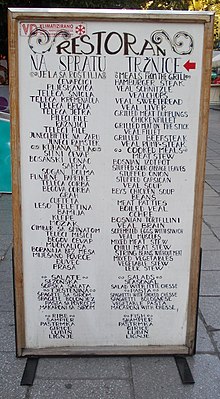
Local food is heavy on meat and fish, and light on vegetarian alternatives. Stews often contain meat but can be created without it. Rice and pasta dishes are readily available. Fast food, with the exceptions of cevapi and pita (or burek) consists of, like in other parts of Europe, pizza, hamburgers and hot dogs. Panini sandwiches are served in most coffee shops popular with the youth, and Bosnian coffee, reminiscent of Turkish coffee, is a must-try for any coffee aficionado. Oddly, apart from these fast food options, Bosnian restaurants serve few Bosnian specialities; what people eat in their homes is very different from what they will eat if they go to a restaurant.
Hearty[edit]

- Cevapi – The ubiquitous Balkan kebab, mostly available in Sarajevo (normally 2-4 KM). There are two prominent variations: the "Banja Luka" Cevap, a larger kebab with a square shape, and the "Sarajevo" Cevap, smaller and round. If you have not had them before, every visitor should try an order of Cevapi at least once. There are several variations of pita (around 2 KM).
- Burek (pita) – A cheap, tasty and readily available snack, a pastry made of filo dough and stuffed with meat (simply Burek), cheese (Sirnica), spinach (Zeljanica), potatoes (Krompirusa) or apple (Jabukovaca). Some examples are better than others, however, and it can be a greasy affair. If you get to Mostar try a plate of trout ("pastrmka", which sounds like "pastrami"), which is the local speciality.
- Trahana – A traditional sourdough soup filling, hand made in most regions and a staple during the fasting month of Ramadan.
- Stews – In every-day cooking, Bosnians eat lots of stew-type meals, like Kupus, a traditional boiled cabbage dish; Grah, beans prepared in a similar fashion, so-called "vegetarian" dish with beans, yet cooked with bacon or smoked meats; and a fairly-runny variation of Hungarian goulash. All are made with garlic, onions, celery and carrots, followed by a vegetable, smoked meat and several cups of water. This is then cooked until the vegetables are falling apart. A local spice called "Vegeta" is incorporated into almost every dish, and the same spice is used throughout the region, as far as Poland. It is comparable to chicken Oxo cubes, or, in other words, condensed chicken broth mix. These type of stew meals will cost you next to nothing, and are very hearty filling meals.
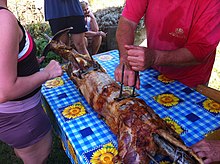
- Janjetina – Basically "lamb on a spit" can be found all along Bosnian roads and recreational places. This is a very tasty treat, usually reserved for special occasions. A whole lamb is cooked on a spit, by rotating over a coal fire for a long time. When you order, you pay by the kilogram, around 25 KM/kg. On special occasions families make such roasts at home.
- Smoked meats – A staple of Bosnian cuisine, more so than the stereotypical foods of pita and cevapi. Amongst the non-Muslim populations, pork rules, and prosciutto, smoked neck, smoked ribs, bacon and hundreds of varieties of smoked sausage make this a real BBQ country. The Muslims have equally-tasty lamb or beef alternatives.
- The meat is prepared by first curing in salt for several days, which removes water and dehydrates the meat, while the high-concentrations of salt preserve the meat from spoiling. After being rubbed with spices (includes some combination of high-quality fresh peppercorns, hot paprika, salt, onions and garlic, and a few spoons of Vegeta, a powdered chicken soup mix similar to an Oxo cube), the meat is then hung over a heavy smoke made by a wood fire. Fruit trees are well known by BBQ aficionados around the world to produce the most flavourful smoke, and apple, cherry and walnut trees are the most commonly used in Bosnia. Whereas commercially produced delicatessen meats are most often dry-cured or hung in dehydrating fridges and only then pressure-smoked for a few hours to allow some flavour to permeate the meat, Bosnian smoked meat is smoked up to three months. The meat hangs in a "smoke house," a tiny wooden shed usually only big enough to light a fire and hang the meat. Bosnians will only smoke meat in the autumn or winter, because the low temperatures, together with the salt curation, allow the meat to hang for months without spoiling. During this time, it is smoked up to 4 times a week, for 8–10 hours at a time, which infuses the meat with the flavor of the smoke and removes any remaining water. The finished product has an incredibly strong aroma and flavor of smoke, with the texture of chewy beef jerky.
- Depending on the cut of meat, the most noticeable difference between smoked meat produced this way and the commercially produced meat available in North America, is the colour inside the meat. Whereas commercial delicatessen meat is usually soft, red, a little wet and fairly raw, Bosnian smoked meat is black throughout with only a slight tinge of pink. Larger cuts of meat, like the Dalmatian prosciutto, do tend to be a bit more pink and softer inside, but the difference is still dramatic, since the Balkan-made prosciutto has much less water, is chewier and overall better smoked. Such meat is most often consumed at breakfast time, in sandwiches, or as meza, a snack commonly brought out to greet guests. Smoked meats are a cheap and incredibly flavorful lunch meat, and can be bought at Bosnian marketplaces from people who usually prepare it themselves. Have a pork neck sandwich with some Bosnian smoked cheese and a salad of fresh tomatoes in a bun of fresh and crisp homemade bread, and you'll never want to leave.
- Meza – A large platter of arranged smoked meats, which usually includes some type of smoked ham (in traditional non-Muslim homes) and sausage thinly cut and beautifully presented with cheese, the well-known Balkan condiment ajvar, hard-boiled eggs and freshly cut tomatoes, cucumbers or other salad vegetables. And as always, bread.
- Cheese – There is supposed to be a large variety, but it is hard to find. Try to find the yellow cheese in oil if you can.
Both soup and salad are commonly served with entrees, chicken & beef soup with noodles or egg dumplings being the most common. The food is generally heavy on fresh produce, which needs little or no added spice. As such, there are few spicy or hot dishes, and dishes advertised as "spicy", such as stews like paprikas or gulash are usually spiced with paprika and not chillies, and do not carry overt pungency. In some regions, and depending on whether it is restaurant or home food, textures and colours can be important also.
Light[edit]
- Bread – No matter what food you order, you are bound to be served bread, commonly consumed throughout some parts of Europe with all savoury foods. Most cookbooks on South Slavonic cooking are packed with hundreds of varieties of breads, this being one of the most bread-crazy regions in the world. Yet, just about the only type of bread in most Bosnians' homes is the store-bought French stick, which the Bosnians would never dream of calling "French"; to them, it is simply "Hljeb" or "Kruh".
- However, more of an effort is made at special occasions to produce traditional Slavonic breads, and each family usually bakes its own variation of a traditional recipe. At Christmas and Easter, Orthodox Serb and Croatian Catholic families typically make a butter-bread called Pogaca, which is often braided and brushed with an egg-wash, giving it a glistening finish perfect for impressive holiday tables. During the month of Ramadan, the Bosniak (Muslim) populations bake countless varieties of breads, and the unique and Turkish-inspired varieties are generally more numerous, diverse and dependent on regions and villages than among Christian populations, where special-event recipes are more homogeneous and fewer selections exist. Lepinja or Somun (the bread served with Cevapi) is a type of flat bread, probably introduced in some form to Bosnia by the Turks, but has since developed independently and is only vaguely reminiscent of Turkish or Middle Eastern flat pita breads. Unlike the Greek or Lebanese pita, the Bosnian Lepinja is chewy and stretchy on the inside and pleasantly textured on the outside, making it a perfect spongy companion to oily meats and barbecue flavors. The Turks may have begun this recipe, but the Bosnians have taken it to a new high.
- Dolma – Fermented vegetables (often wine leaves) stuffed with rice and meat.
- Salads – Typically composed of mixed tomatoes, lettuce, onions and bell peppers, often with feta cheese. A Caesar salad is unheard of in Bosnia, and generally most vinaigrettes are of the Italian variety, balsamic vinegar and olive or corn oil. You may also come across many condiments.
- Ajvar – A canned (or home made if you are lucky) spread, something like a bruschetta spread, made of roasted peppers & aubergine (eggplant), which are ground and seasoned with pepper and salt and slow cooked.
- Pickled vegetables – Served as condiments, such as pickled peppers, onions, cucumbers ("pickles"), and tomatoes.
- Kajmak – A dairy spread, similar to cream cheese but with a dryer texture. It is made of milk fat, which is salted and canned. It has a smoky, salty cheese taste. Kajmak from Travnik is a local speciality and is exported as far as Australia.
Bosnian food generally does not combine sweet and savoury foods, and you will never encounter such a thing as a Caesar salad with mandarin oranges. Nevertheless, many a fine chef will experiment with sweet and savoury tastes like the 'Medeno Meso' (Honeyed Meat) made in pre-war Banja Luka by a well known chef. The delineation between fruit and vegetables is strong, with fruit used only for dessert-type dishes. You will never encounter any dish where sugar is added unless it's a dessert.
Desserts[edit]
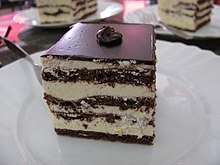
- Ice cream – Sold in most former Yugoslav countries and with several varieties, but regional milk and cream must be a contributing factor to their wonderful taste. You can buy ice cream either by the scoop or from an iced-milk swirl machine, packaged in stores or from a street vendor. Recommended is the "Egypt Ice Creamery' in Sarajevo, famous in the region for their caramel ice cream. Also try "Ledo", a type of packaged ice cream made in Croatia but sold throughout the region.
- Krempita – A type of custard/pudding dessert that tastes something like a creamy cheesecake.
- Sampita – Similar to Krempita, a dessert made with egg whites.
- Hurmasice (Hurme) – A small finger-shaped wet traditional Bosnian sweet with walnuts.
- Tulumbe – Also a traditional Bosnian dessert, something like a tubular doughnut, crispy on the outside and soft and sweet on the inside.
- Tufahija – Another known dessert in Bosnia, which is a peeled apple with some sweet chocolate-covered walnut that sometimes is served with whipped cream on top.
- Baklava – And of course, don't forget to try Bosnia's take on the world-famous sweet, which tends to be somewhat more syrupy than its Turkish counterpart and usually does not contain any rum, like its Greek counterpart. Much of the traditional cooking has Turkish undertones, a colourful consequence of six hundred years of Ottoman rule over most of Bosnia & Herzegovina, and desserts are no different.
Fruits and vegetables[edit]
The cuisine of the country has not yet been ruined by commercially-grown produce, most foods are (uncertified) organically or semi-organically grown, using fewer chemicals and are picked when ripe. Generally, all foods are as fresh as it gets. The vegetable markets sell only seasonal and locally-grown vegetables, and you are bound to have some of the best tasting fruit you've ever tried in the Neretva Valley region of Herzegovina (close to the Croatian border, between Mostar and Metkovic). The region is famous for peaches, mandarin oranges, peppers & tomatoes, cherries (both the sweet and the sour variety), watermelons and most Kiwi fruits.
Where[edit]
When you visit a Bosnian at home, the hospitality offered can be rather overwhelming. Coffee is almost always served with some home-made sweet, such as breads, cookies or cakes, together with meza.
- Aščinica – A storefront restaurant serving cooked (as opposed to grilled or baked).
- Buregdžinica – A place where the main dishes are filled pastries (burek, sirnica, etc.).
- Cevapdzinica – Also a storefront restaurant that serves grilled Cevapi, a delicacy that is a must-try in Bosnia & Herzegovina.
- Pekara – A bakery where you can buy bread and baked confectioneries.
Drink[edit]

The legal drinking age in Bosnia and Herzegovina is 18 years. Popular domestic beers are Nektar (from Banja Luka), Sarajevsko, Preminger (from Bihać, made according to a Czech recipe) and Tuzlansko, while the most common imports are Ozujsko and Karlovačko from Croatia, Jelen from Serbia, and Laško and Union from Slovenia. Like in almost every European country, beer is very common and popular. Even in more heavily Islamic areas alcohol is available in abundance to those who choose to drink and almost every bar is fully stocked.
Like most Slavs, Bosnians make 'Rakija' which comes in many a variety and is made both commercially and at home. Red wine is 'Crno vino' (Black wine) and white wine is 'bijelo vino'. Wines from Herzegovina are renowned for their quality. Alcohol is not taxed as heavily as in most Western nations and is often very affordable. Quality alcohol is sought after and valued.
Bosnians are among the biggest coffee drinkers in the world, particularly Turkish coffee, locally called Bosnian or domaca (homemade) coffee, which can be bought in every bar, restaurant or fast food place.
Sleep[edit]
In Bosnia and Herzegovina you can choose from the great number of hotels, hostels, motels and pensions. At the seaside town of Neum you can book hotels from 2–4 stars. In the other cities many hotels are 3 stars, 4 stars and some of them are 5 stars.
In Banja Luka the best hotels are: Cezar, Palas, Bosna, Atina, Cubic and Talija.
In Sarajevo the best hotels are: Hollywood, Holiday Inn, Bosnia, Saraj, Park, Grand and Astra.
Campsites are not very common. An overview of campsites in Bosnia is available at the national tourism agency [4] [dead link]. Wild camping is often no problem, but be careful for mines.
Work[edit]
Bosnia has one of the highest unemployment rates in Europe (around 17%), and rates of pay are somewhat low compared to other European countries—the average monthly wage is €1,000–2,000.
A complex bureaucratic system, corruption, and political inefficiency mean that working conditions in Bosnia are not that ideal.
Stay safe[edit]
Land mines[edit]
| Note: Due to the constant landmine threat it is better not to leave paved roads, even for a pee-break in areas you are not familiar with. Plans are to finish the clearing in a few years, but experts estimate the work to take decades. | |
| (Information last updated 08 Dec 2023) |
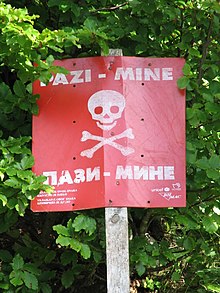

Be very careful when travelling off the beaten path in Bosnia and Herzegovina: it is still clearing many of the estimated 5 million land mines left around the countryside during the Bosnian War of 1992–1995.
Some rules:
- Abide to the warning signs around everywhere
- Whenever you're in rural areas, try to stay on paved areas if possible.
- If an area or property looks abandoned, stay away from it. Some of the houses and private properties that were abandoned by their owners were often rigged with mines during the war, and so they still pose a threat to anyone who trespasses.
- Never touch any unknown item. If you suddenly find a suspicious or unknown object, you must report it to the police, as this will help to keep locals and future visitors safe.
In case you are still suspicious and want to at least get a feel for where dangers lurk, there exists a rough map layer for OsmAnd online based on the picture here. It is not to be relied on, but at least can give you an indication on where you are.
Footpaths are free of mines, and the grass to the side of them is mostly demined but the odd mine remains in some rural areas.
Crime[edit]
Bosnia experiences very little violent crime. However, in the old centre of Sarajevo and in other cities such as Mostar and Banja Luka, beware of pickpockets.
Dogs[edit]
Bosnia has far less stray and street dogs than many other Eastern European countries. Just some regions seem not to adhere to this rule like Mostar and everything south of it. See Aggressive dogs for more information on how to deal with this situation.
Traffic[edit]
Traffic is probably the biggest danger in Bosnia and Herzegovina. In cities and on major roads, traffic is well regulated but the driving behaviours are still hostile. Bosnian drivers are also known to speed down small mountain roads. Roads aside from the main roads are mediocre at best, and sometimes in total state of decay.
Stay healthy[edit]
All Bosnian employees undergo regular health checks to ensure that they can physically do their jobs and that they will not transmit any disease or injure anyone. People in the food industry are particularly checked and random health and safety checks for the premises are held often. Food handlers and providers are held to the highest standards. Bosnian kitchens and food storehouses are expected to be sanitary and spotless and food safety is very important.
Tap water is drinkable in most parts of the country, there's even "hajrli česme" or "safe travel fountains" in some parts of the country which offers drinkable water from the source of a mountain.
Since the food is rich, some extra exercise may help.
And as above, never walk off dedicated paths in case of land mines.
Cope[edit]
Smoking is allowed nearly everywhere in the country, and over half the population use tobacco. Therefore, be prepared to endure very smoky restaurants, bars and shopping centres, as well as other establishments. Even bus drivers often smoke while driving.
Respect[edit]
It is of utmost importance to respect the religious differences of the people in the region, and their effort to move past the 1990s war, as it still affects those that survived those times to this day. Be careful in areas where there is still some form of ethnic tension, and ensure that you do not offend a particular group. Avoid talking about the war, or any other controversial topic in the Balkans, such as the legitimacy of Kosovo or Republika Srpska; it's very disrespectful and you won't get any good information from doing so, since everyone tends to be biased on what they perceive to be good or bad, like most parts of the world.
Muslims constitute 50-52% of the population, making Bosnia one of the few Muslim-majority countries in Europe. The form of Islam practised by the vast majority of Bosnians is liberal, and it is common for Bosnian Muslims to consume alcohol and somewhat common to eat pork.
Similarly, respect the environment. A lot of the country, as well as its neighbours, have been spared from pollution and it is very important to be careful of your influences.
The streams and rivers tend to be fierce, the mountains and valleys often unguarded and the footing unsure. Always have a tour guide with you or consult a local for advice on the natural dangers and land mines.
Connect[edit]
Each entity has its own postal service, so stamps bought in the Federation cannot be used in the RS and vice versa.
There are many mobile phone networks in Bosnia and Herzegovina, e.g.: HT ERONET (Mostar), GSMBiH (Sarajevo) and m:tel (Republika Srpska, Banja Luka) You can buy a prepaid SIM card from any network at any kiosk for 10 KM or less. Often operators offer special data only packages for tourists with a validity of 5-30 days (e.g. 30 days with 30GB for 40 KM).
The activation of any Bosnian SIM card takes less than 2 minutes, no proof of identity or any other bureaucratic steps are required.
Note that you can use Bosnian SIM cards in other West Balkan countries. Sometimes this requires a minimal "top up" of your call and SMS budget which you can also get at kiosks, if you know your phone number.
Go next[edit]
The land border can be crossed to Croatia, Montenegro and Serbia.

